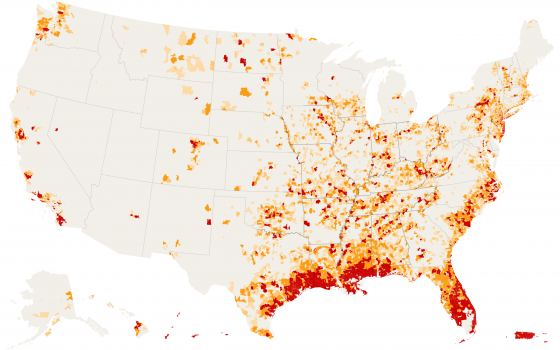This report was originally published by Sara Tipton at Tess Pennington’s ReadyNutrition.com.
Tess is the author of The Prepper’s Blueprint: How To Survive ANY Disaster.

With constant media bombardment of fears of a nuclear war, many have begun to prepare for a disaster. But government uncertainty isn’t the only thing on the minds of the masses. Volcanic activity appears to be increasing and earthquakes seem to be getting more severe. That begs the question: do you live in a disaster zone?
In just the past 16 years, parts of Louisiana have been struck by six hurricanes. Areas near San Diego were devastated by three particularly vicious wildfire seasons. And a town in eastern Kentucky has been pummeled by at least nine storms severe enough to warrant federal assistance. These are obvious red flag areas, but what about the rest of the country?
The New York Times has put together a map showing which areas in the United States were subjected to the most disasters which caused monetary losses by ZIP code between 2002 – 2017.

The statistics for living in the “red zones” in the above map are not comforting either. About 90 percent of the total losses across the United States occurred in ZIP codes that contain less than 20 percent of the national population, according to an analysis of data from the Small Business Administration.
In the first three months of 2018, billion-dollar storms hit the United States three times. By contrast, in the first three months of an average year, just one disaster that causes more than a billion dollars in damages occurs,according to National Oceanic and Atmospheric Administration records dating back to 1980.
The National Oceanic and Atmospheric Administration (NOAA) attempts to calculate the full cost of major disasters, namely those that cause more than a billion dollars in damages. It estimates that 2017 was the costliest year on record, with 16 billion-dollar disasters that together cost the United States more than $300 billion. While natural disasters are often unpredictable, the annual losses from billion-dollar disasters, which were adjusted for inflation, have increased over the last 40 years.
Because the federal government continues to use taxpayer funds to subsidize the disaster zones, critics feel that the money is being wasted by continuing to help people live in places that they know will be hit by a hurricane or deadly storm. Christina DeConcini, the director of government affairs at the World Resources Institute, said that instead of just being responsive, the government should stress building for resilience against the disasters that continue to cost people money.
About 4 percent of all hurricanes that make landfall globally hit the United States, said Robert Mendelsohn, an economist at Yale University who studies the damage caused by hurricanes. However, 60 percent of worldwide damage from hurricanes happens in the United States. Dr. Mendelsohn attributed this partly to federal government programs that discourage citizens and local governments from building walls to protect housing near the coast. Only in the United States do relief programs and subsidized insurance make it attractive for people to move toward disaster-prone areas, he told The New York Times.
People continue to live in disaster areas mostly because of their financial situation, whether it be a lot or too little money. Phil Klotzbach, an atmospheric scientist at Colorado State University, said that the rise in population and wealth near the coasts was contributing to most of the increase in the destruction caused by hurricanes. Bigger and more expensive homes require more money to repair in the event of a natural disaster, and many even in the middle class are being squeezed out of coastal areas due to the cost of living. In 2016, there were more than 3.6 times as many homes in states that border the Gulf of Mexico and the Atlantic Ocean as in 1940, according to the Census Bureau.
Others say that their family ties and lack of funds to support a move are keeping them in areas prone to natural disasters. Linda Lowe, the president of a historical society in flood-prone Olive Hill, Kentucky said that rather than move the town, “it’s easier to throw your hands up and say, ‘Forget it.’” Dr. Irwin Redlener, the director of the National Center for Disaster Preparedness at Columbia University said rationality often goes out the window when discussing things like disasters and their destructive potential on a person’s life. “Abandoning a location and moving a city makes sense from a scientific, risk point of view, but the fact is that to get to a place culturally and psychologically where that conversation can be tolerated is a difficult thing to imagine,” said Redlener. “It’s not all that rational — but I guess a lot of these things are not really rational,” he added according to The New York Times.
But some residents have decided to stay in disaster zones and use their time between hurricanes to prepare themselves for the next storm. It’s often the best way to protect against monetary and life losses, said one Louisiana resident. Susan McClamroch, who works at a museum in Slidell, Louisiana, said that locals joke that they “start eating everything in the freezer” this time of year because of the likelihood of a power failure after a hurricane.
If you cannot relocate, or do not wish to relocate, consider storing some food and water in a safe place just in case disaster strikes.
***
(Sign up for our FREE newsletter to get the latest prepping advice, gardening secrets, homesteading tips and more delivered straight to your inbox!)
Additional Resources:
The Prepper’s Blueprint: The Step-By-Step Guide To Help You Through Any Disaster
Prepper’s Home Defense: Security Strategies to Protect Your Family by Any Means Necessary
The Survival Medicine Handbook: A Guide for When Help is Not on the Way
SAS Survival Handbook, Revised Edition: For Any Climate, in Any Situation
Tess Pennington is the author of The Prepper’s Blueprint, a comprehensive guide that uses real-life scenarios to help you prepare for any disaster. Because a crisis rarely stops with a triggering event the aftermath can spiral, having the capacity to cripple our normal ways of life. The well-rounded, multi-layered approach outlined in the Blueprint helps you make sense of a wide array of preparedness concepts through easily digestible action items and supply lists.
Tess is also the author of the highly rated Prepper’s Cookbook, which helps you to create a plan for stocking, organizing and maintaining a proper emergency food supply and includes over 300 recipes for nutritious, delicious, life-saving meals.
Visit her web site at ReadyNutrition.com for an extensive compilation of free information on preparedness, homesteading, and healthy living.










0 Comments